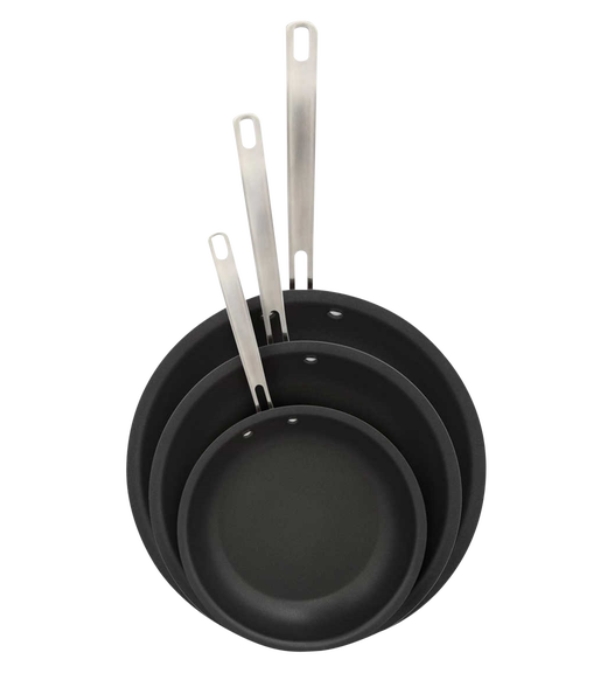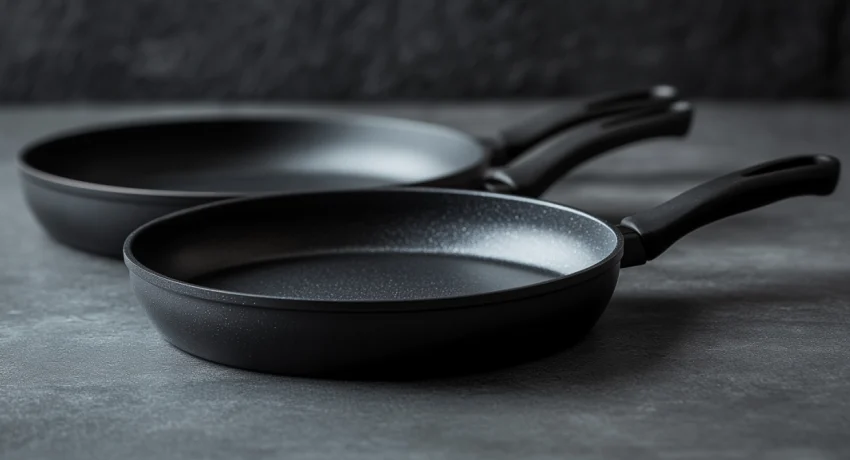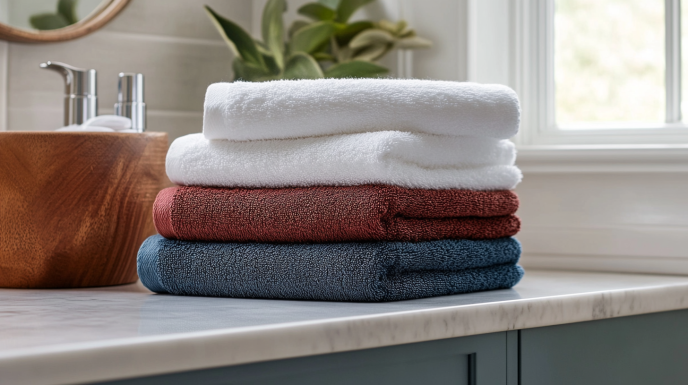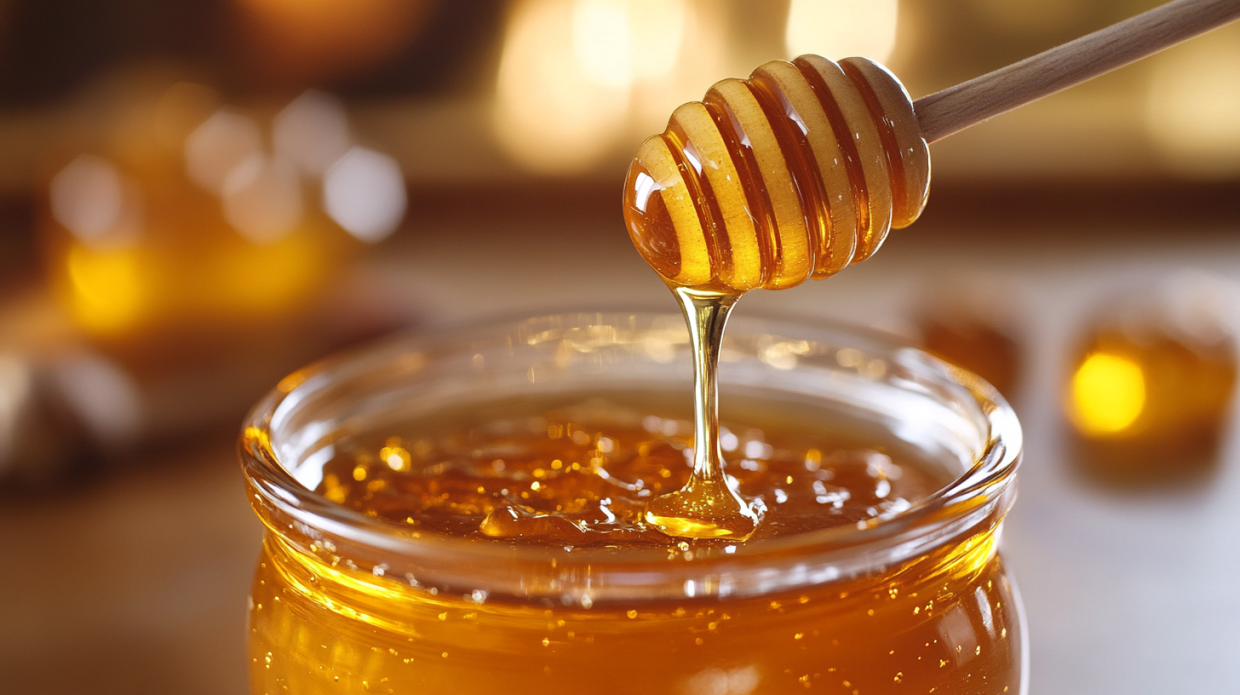
Kirkland Signature Hard Anodized Skillets
3-piece
- Hard anodized
- Stay cool handles
- PFOA free
- Non-stick Whitford Eclipse HB Coating
Unveiling the Hidden Champion of Home Cooking: Quality Without the Premium Price Tag
In the vast landscape of cookware options, finding the perfect balance between quality, performance, and affordability often feels like searching for a culinary unicorn. While premium brands dominate cooking shows and social media feeds, savvy home chefs have discovered a not-so-secret weapon hiding in plain sight at their local warehouse club. Kirkland Signature pans represent one of the best values in cookware today, offering professional-grade performance without the eye-watering price tag of luxury brands.
As someone who has spent countless hours testing different cookware (and burning more than a few meals along the way), I’ve developed a healthy skepticism toward both budget options that disappoint and premium brands that overcharge. That’s why my discovery of Kirkland pans felt like finding hidden treasure in the sprawling aisles of Costco. These versatile kitchen workhorses have transformed my cooking experience, prompting me to share this deep dive into everything you need to know about them.
Whether you’re a curious Costco member wondering if these pans are worth adding to your cart, or you’re simply researching cookware options, this comprehensive guide will answer all your questions about Kirkland pans. From materials and construction to performance and value, let’s explore why these unassuming pans have developed such a devoted following among home cooks and professional chefs alike.
Material Matters: What Are Kirkland Pans Made Of?
The foundation of any quality cookware starts with its materials, and Kirkland Signature doesn’t cut corners here. The current lineup of Kirkland pans primarily features tri-ply stainless steel construction, though they’ve offered hard-anodized aluminum and non-stick options in past seasons.
The flagship stainless steel pans feature a three-layer construction: an aluminum core sandwiched between layers of 18/10 stainless steel. This tri-ply design combines the best of both worlds—the excellent heat conductivity of aluminum with the durability and non-reactive properties of stainless steel. The 18/10 designation indicates the steel contains 18% chromium and 10% nickel, creating a corrosion-resistant, non-reactive cooking surface that won’t leach metals into your food.
For the non-stick options, Kirkland uses a PFOA-free coating that provides excellent food release properties while addressing health concerns associated with older non-stick technologies. The hard-anodized aluminum versions feature electrochemically hardened aluminum that’s twice as strong as stainless steel, offering excellent durability and heat distribution.
What’s particularly impressive is how this construction compares to premium brands costing two to three times as much. The weight, balance, and thickness of Kirkland pans suggest thoughtful engineering rather than cost-cutting compromises. When handling one, you’ll immediately notice the substantial feel—not too heavy to maneuver comfortably, but weighty enough to indicate quality materials and construction.
The Costco Connection: Where to Find Kirkland Pans
As Kirkland Signature is Costco’s house brand, these pans are exclusively available through Costco channels. You’ll find them in the housewares section of physical Costco warehouse locations, though specific availability can vary by store and season. Costco’s rotating inventory approach means particular sets or individual pieces might not always be in stock, which has created something of a “get them while you can” mentality among dedicated fans.
For those who prefer online shopping, Kirkland pans are also available on Costco.com. The online selection sometimes includes exclusive sets or pieces not found in warehouses. Keep in mind that purchasing from Costco.com typically requires a membership, though occasional promotions might allow non-members to shop online with a surcharge.
This limited distribution channel is both a blessing and a curse. On one hand, you won’t find these pans at other retailers or even on major marketplaces like Amazon (at least not officially). On the other hand, this exclusivity helps Costco maintain strict quality control while keeping prices remarkably competitive.
If you’re not a Costco member, the value proposition of Kirkland pans might actually justify the membership fee, especially if you’re in the market for a complete cookware set. A Costco membership starts at around $60 annually, and the savings on a single set of quality cookware could easily exceed that amount compared to similar offerings from mainstream brands.
The Non-Stick Question: Performance and Durability
Among the most frequently asked questions about Kirkland pans concerns their non-stick offerings. The answer is yes—Kirkland does offer non-stick cookware options, and they perform admirably in this competitive category.
Current Kirkland non-stick pans feature a PFOA-free coating that provides excellent food release properties. The non-stick surface allows for cooking delicate items like eggs and fish with minimal oil, and cleanup is remarkably effortless. Many users report that pancakes, omelets, and other sticky foods slide off the surface with ease, even after months of regular use.
However, it’s worth noting that like all non-stick cookware, Kirkland’s versions have a finite lifespan. The coating will eventually wear down with use, particularly if exposed to high heat, metal utensils, or abrasive cleaning methods. Most users report getting 2-3 years of excellent performance before noticing a decline in non-stick properties, which is comparable to much pricier alternatives.
What sets Kirkland’s non-stick options apart is their thoughtful construction beyond just the coating. The pans feature substantial weight and excellent heat distribution, preventing hot spots that can lead to uneven cooking. The thick base helps maintain consistent temperatures, allowing for better searing and browning than many lightweight non-stick competitors.
For those concerned about the health aspects of non-stick coatings, it’s reassuring to know that Kirkland’s modern non-stick surfaces are PFOA-free and designed to be safe when used according to directions. This means avoiding extreme high heat and not using metal utensils that might scratch the surface.
Value Proposition: Kirkland Pans Pricing
Perhaps the most compelling aspect of Kirkland pans is their extraordinary value proposition. While prices can vary by location and over time, the general pricing structure positions these pans as an exceptional buy when comparing specifications and performance to similar cookware.
Individual Kirkland stainless steel pans typically range from $15-45 depending on size and style, while complete sets usually fall between $150-300. The non-stick options are priced even more aggressively, with individual pans often available for $20-35 and sets for $100-200.
To put this in perspective, comparable tri-ply stainless steel pans from mainstream brands like All-Clad, Calphalon, or even mid-tier brands like Cuisinart often cost 2-3 times as much. A single 12-inch All-Clad stainless skillet might retail for $120-150, while the Kirkland equivalent could be had for $40-50 with similar construction and performance characteristics.
What makes this value even more remarkable is that Kirkland doesn’t achieve these price points through obvious quality compromises. The materials, construction, and finishing details all suggest cookware that should cost significantly more. This value is likely achieved through Costco’s efficient supply chain, economy of scale, and their strategy of offering fewer, carefully selected products rather than extensive lines with minor variations.
For home cooks on a budget, this means access to professional-grade cookware that would otherwise be out of reach. For more affluent consumers, it represents an opportunity to outfit secondary homes or expand a cookware collection without unnecessary expense. In either case, Kirkland pans offer performance that punches well above their price weight.
Heat Management: Oven Safety and Stovetop Compatibility
Modern cooking often requires versatile cookware that can transition from stovetop to oven, and Kirkland pans excel in this regard. The stainless steel line is fully oven-safe, with most pieces rated for temperatures up to 500°F (260°C), including their lids. This makes them suitable for recipes that start on the stovetop and finish in the oven, like seared steaks, frittatas, or skillet desserts.
For the non-stick options, temperature ratings are typically more conservative to protect the coating, with most pieces safe up to 400°F (204°C). The lids for non-stick pieces may have lower temperature ratings, especially if they include plastic components.
When it comes to stovetop compatibility, Kirkland pans demonstrate impressive versatility. The stainless steel line works beautifully on all cooking surfaces—gas, electric, ceramic, and even induction. This induction compatibility is particularly noteworthy, as many mid-priced cookware lines still don’t offer this feature despite the growing popularity of induction cooktops.
The hard-anodized aluminum options are generally compatible with gas, electric, and ceramic surfaces, though not all versions work with induction unless specifically labeled as induction-compatible. If induction cooking is important to you, be sure to check the packaging details for compatibility.
This versatility across cooking methods reflects thoughtful engineering, as creating pans that perform well across different heat sources requires careful consideration of materials and construction. The heavy, flat bases ensure excellent contact with flat cooktops, while the responsive heat conduction works well with the more immediate temperature changes of gas cooking.
Cleanup and Maintenance: Keeping Your Kirkland Pans Looking New
Kitchen efficiency isn’t just about cooking performance—it’s also about cleanup and maintenance. Here again, Kirkland pans offer convenient options for busy home cooks.
Most Kirkland pans, including the stainless steel line, are dishwasher-safe, though as with all quality cookware, hand washing is recommended for maximum longevity. The stainless steel pieces can withstand the dishwasher without damage, making them practical for everyday use when time is limited.
For the non-stick options, hand washing with mild soap and a soft sponge is strongly recommended to preserve the coating. Abrasive cleaners, steel wool, and metal scrubbing tools should be avoided as they can damage the non-stick surface.
When hand washing stainless steel pieces, warm soapy water is usually sufficient for routine cleaning. For stuck-on food or discoloration, a paste of baking soda and water works wonders without scratching. Bar Keepers Friend, a mild abrasive cleaner, is also excellent for restoring the shine to stainless steel surfaces that have developed discoloration from high-heat cooking.
One maintenance tip that applies to all Kirkland pans: avoid thermal shock. Plunging a hot pan into cold water can cause warping over time, potentially compromising the flat cooking surface that’s so essential for even heating. Instead, allow pans to cool naturally before cleaning.
With proper care, Kirkland pans can maintain their appearance and performance for many years. The stainless steel options are particularly resilient, often looking almost new after years of regular use. Even the non-stick versions, while having a more limited lifespan by nature, tend to outlast many competitors when properly maintained.
Size and Selection: Finding the Right Kirkland Pan for Your Needs
Kirkland offers a thoughtful selection of pan sizes and styles, though not the extensive range you might find from cookware specialists. The focus is on versatile, everyday pieces rather than highly specialized tools.
In the stainless steel line, you’ll typically find fry pans in 10″ and 12″ diameters, saucepans in 2-quart and 3-quart capacities, a 4-quart sauté pan, and an 8-quart stockpot. These core pieces address the needs of most home cooks without overwhelming them with options.
The non-stick offerings usually include 10″ and 12″ fry pans, sometimes with a smaller 8″ option included in sets. Some seasons have featured deep sauté pans or chef’s pans with non-stick coatings as well.
Sets typically include 6-13 pieces (counting lids as separate pieces, as is standard in the industry). A common configuration for the stainless steel set includes 10″ and 12″ fry pans, 2-quart and 3-quart saucepans with lids, a 4-quart sauté pan with lid, and an 8-quart stockpot with lid.
While not offering the breadth of specialized pieces found in extensive cookware lines, Kirkland’s focused selection covers the core needs of most home kitchens. This streamlined approach likely contributes to the value proposition, as production can focus on perfecting fewer pieces rather than creating dozens of variations.
For those wanting to mix and match, individual pieces are sometimes available, though the best value is typically found in the sets. If you’re looking for highly specialized cookware like woks, paella pans, or fish poachers, you’ll need to supplement your Kirkland collection with pieces from other brands.
Comparative Analysis: How Kirkland Pans Stack Up Against the Competition
In the crowded cookware market, how do Kirkland pans compare to established brands? This is perhaps the most revealing aspect of their value proposition.
When compared to premium brands like All-Clad, Demeyere, or Mauviel, Kirkland pans offer remarkably similar construction and performance at a fraction of the price. The tri-ply stainless steel construction, with its aluminum core, creates heat distribution that rivals pans costing three times as much. While the premium brands might offer marginally better finishing details or slightly more refined handles, the functional cooking performance is comparable where it matters most.
Against mid-tier brands like Cuisinart, Calphalon, or Tramontina, Kirkland pans generally match or exceed quality while undercutting prices by 20-40%. The weight, balance, and durability of Kirkland pans often feel more premium than these mid-range competitors.
When compared to budget brands, there’s simply no contest. Kirkland pans offer substantially better materials, construction, and performance while often costing just slightly more than the cheapest options available. The difference in cooking experience and longevity easily justifies the modest price premium over true budget cookware.
What Kirkland pans might lack compared to specialized cookware brands is the extensive range of options and some of the most advanced technologies. You won’t find copper-core options, seven-ply construction, or specialized pieces for niche cooking techniques. However, for the core cookware that most home cooks use daily, Kirkland’s offerings compete surprisingly well with brands costing far more.
Warranty and Customer Satisfaction: The Costco Advantage
One significant advantage of Kirkland products is Costco’s legendary return policy and commitment to customer satisfaction. While the specific warranty terms for Kirkland pans may vary by product and season, Costco’s general return policy allows members to return most items at any time if they’re not completely satisfied.
This generous approach provides significant peace of mind when investing in cookware. If a pan warps, develops issues with its non-stick coating, or otherwise fails to meet expectations, Costco typically accepts returns without hassle. This informal “satisfaction guarantee” often exceeds the explicit warranties offered by many cookware manufacturers.
For the stainless steel line, which should last for decades with proper care, this policy is less likely to come into play. However, for non-stick options with their inherently limited lifespan, Costco’s approach to customer satisfaction provides valuable insurance against premature failure.
Beyond the formal warranty, Kirkland pans benefit from consistently positive customer reviews. Online ratings typically average 4.5-4.8 out of 5 stars, with particular praise for durability, even heating, and value for money. Negative reviews tend to focus on the expected limitations of certain materials (like food sticking to stainless steel) rather than quality or performance issues, suggesting that the pans meet or exceed reasonable expectations.
Health and Safety: Material Considerations
Health-conscious cooks often express concerns about cookware materials, and Kirkland pans address these considerations thoughtfully.
The stainless steel line offers a cooking surface that’s non-reactive, meaning it won’t leach metals into food even when cooking acidic ingredients like tomato sauce or citrus. The 18/10 stainless steel used is food-safe and highly stable, making it an excellent choice for health-focused cooking.
For the non-stick options, Kirkland uses PFOA-free coatings, addressing concerns about older non-stick technologies. While all non-stick coatings have temperature limitations (typically not recommended for high-heat cooking above 400°F), when used according to guidelines, modern non-stick surfaces like those on Kirkland pans are considered safe for everyday cooking.
The hard-anodized aluminum versions feature a sealed surface that prevents raw aluminum from contacting food, eliminating concerns about aluminum leaching. The anodization process creates a hard, non-reactive surface that’s safe for cooking all types of food.
All Kirkland cookware is designed to meet or exceed safety standards for materials that come into contact with food. This focus on food-safe materials without unnecessary chemical additives aligns with increasing consumer demand for healthier cooking options.
Cooking Performance: From Searing to Simmering
The true test of any cookware comes when it’s put to work in a real kitchen, and Kirkland pans excel across a wide range of cooking techniques.
For high-heat cooking like searing steaks or stir-frying vegetables, the stainless steel line provides excellent heat retention and distribution. The substantial weight helps maintain temperature when cold food is added to the hot pan, essential for achieving a proper sear. The tri-ply construction distributes heat evenly across the cooking surface, eliminating hot spots that can lead to uneven cooking.
For delicate cooking like simmering sauces or preparing custards, the responsive heat conduction allows for precise temperature control. The heavy bases prevent scorching, while the quality materials respond quickly to adjustments in heat level.
The non-stick options shine when cooking foods prone to sticking, like eggs, fish fillets, or pancakes. The effective release properties allow for cooking with minimal fat, supporting healthier cooking approaches. While not ideal for high-heat searing (due to temperature limitations of non-stick coatings), they excel at medium-heat cooking tasks.
Particularly impressive is how Kirkland pans handle the transition between cooking techniques. A stainless steel fry pan can go from searing chicken on the stovetop to finishing in the oven, then deglazed to create a pan sauce—all with excellent results at each stage. This versatility makes these pans true kitchen workhorses that can adapt to various cooking methods and recipes.
Ergonomics and Design: The User Experience
Cookware design goes beyond materials and construction—the user experience matters tremendously during actual cooking. Kirkland pans feature thoughtful ergonomic elements that enhance their everyday usability.
The handles on most Kirkland stainless steel pans are securely riveted to the pan body, creating a stable connection that won’t loosen over time. The handle design typically features a slight contour that fits comfortably in the hand, with enough length to provide leverage when moving a full pan.
Most importantly, the handles are designed to stay relatively cool during stovetop cooking, though they will heat up during oven use. This thermal resistance allows for comfortable handling without constantly reaching for potholders during routine cooking.
The lids fit securely, with stainless steel rims that create a good seal against the pan. Some sets feature glass lids that allow for monitoring food without releasing heat, while others offer all-metal lids for maximum oven compatibility.
The rims of Kirkland pans are typically tapered to allow for clean, drip-free pouring—a small but significant design detail that prevents messy countertops when transferring liquids. The interior corners of saucepans and stockpots have a slight radius rather than a sharp angle, making them easier to clean thoroughly and reducing areas where food might stick.
While not featuring the most innovative or distinctive design aesthetics in the cookware world, Kirkland pans offer a clean, professional appearance that ages well. The focus seems to be on functional design rather than trendy aesthetics, resulting in cookware that looks appropriate in any kitchen and won’t appear dated as styles change.
The Final Assessment: Are Kirkland Pans Worth It?
After examining materials, performance, value, and user experience, the verdict on Kirkland pans is overwhelmingly positive. For most home cooks, these pans represent one of the best values in the cookware market today.
The stainless steel line offers professional-grade performance at entry-level prices, with construction and materials that rival much more expensive brands. The non-stick options provide excellent food release and even heating at price points that make replacing them every few years (as all non-stick eventually requires) far more palatable.
What makes Kirkland pans truly exceptional is their intersection of quality and affordability, delivering premium performance without the premium price tag. For home cooks looking to upgrade from basic cookware without investing in luxury brands, Kirkland pans hit a sweet spot that few competitors can match.
The limited availability through Costco channels is the only significant drawback, potentially requiring a membership or special trip to access these products. However, for many home cooks, this minor inconvenience is well worth the value received.
Whether you’re outfitting your first kitchen, upgrading worn-out cookware, or adding to an existing collection, Kirkland pans deserve serious consideration. In a market often driven by brand prestige and marketing hype, these unassuming pans let their performance and value speak for themselves—and what they say is impressive indeed.
For the practical home cook who values performance over prestige and substance over style, Kirkland pans represent one of the best-kept secrets in the cookware world. The next time you’re navigating Costco’s aisles, take a detour to the housewares section—your kitchen and your wallet will thank you.




